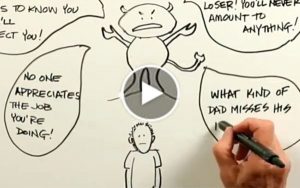The Anti-Self Vs. The True Self

For a long time we’ve speculated the falling economy could mean a rise in the suicide rate, and now, new research has given us some indication. In April, the Centers for Disease Control and Prevention issued a release stating the overall suicide rate rises and falls in connection with the economy. This conclusion was drawn from a U.S. study looking at suicide rates from 1928-2007.
In August, another report released by the CDC showed that in 2008, 13.4 percent of people who committed suicide had experienced job and financial problems. This marks about a 2 percent increase in these figures from previous years, leading the CDC to recommend increasing counseling, job placement and financial services that can help reduce the mental distress that can heighten suicide risk. We live in a world where more people die by suicide than from all homicides and wars combined. And with today’s uncertain economic climate, there has never been a more crucial time to learn what we can do to prevent this crisis and help save a life.
A common misconception about suicide is the belief that a suicidal person wants to die, and that they cannot be helped. This is far from being the case. The suicidal state is almost always short-lived and treatable. When someone decides to end their life, they are acting out the will of an internal enemy or “anti-self.” A suicidal individual is divided between their true self that is on their side and wants to live and an anti-self which attempts to destroy them. By understanding this division, suicidal individuals can begin to challenge the distorted filter through which they view the world when in a suicidal state.
Emerging from a suicidal state involves reconnecting with and strengthening one’s real self and rediscovering the natural desire to survive. For many people who have attempted suicide, this reconnection took place the minute they make a serious attempt to end their lives. Tragically for many, this realization that they do not want to die has come just a few seconds too late. This is why it is necessary for us to intervene as soon as possible when we feel concerned that someone is falling into hard times and may be suicidal.
With so many individuals suffering losses of jobs, homes or retirement security, the potential for the anti-self to gain strength is increased. The most common mental health outcome of these difficult conditions is depression, which increases suicide risk. A recent study of 26 European Union countries showed that for every 1 percent rise in unemployment, there was a .79 percent increase in suicides among individuals younger than 65 years old. This same report showed that a 3 percent or greater rise in unemployment was associated with a 4.45 percent rise in suicide.
In the U.S., a study by economist Christopher J. Ruhm similarly showed that for every 1 percent increase in a state’s unemployment rate, the number of suicides increases by 1.3 percent. Other research tracking suicide rates from 1960 to 1995 has demonstrated that each $1.00 cut in state per capita public welfare expenditures was associated with an increase of .004 per 100,000 population in state suicide rates.
Though data as current and comprehensive as that offered by the EU study has yet to be reported in the U.S., the CDC has suggested that “Job loss can trigger a cascade of negative events, such as more financial problems and relationship problems, which can increase risk for suicide.” These stressors and losses can trigger feelings of shame, humiliation or despair, which may lead to suicide attempts in vulnerable individuals or those with limited support and resources. However, the situation is far from hopeless. Like depression, suicidality is almost always both preventable and treatable. Yet, in order to prevent it, we must be willing to intervene. Something as small as a smile from a stranger or a friend showing that they care has been known to save someone from suicide. However, when we avoid the subject of suicide we fail to learn to recognize the warning signs and learn the helper tasks that can save a life.
By educating ourselves in the dos and don’ts of suicide prevention, we equip ourselves with the tools to help someone we may encounter who is in need, be it a co-worker, friend, relative, neighbor or acquaintance. The most important “don’t” is never ignore someone you’re worried may be suicidal. Never assume they are just joking or seeking attention or aren’t serious about making a suicide attempt. By heightening our understanding of how we can prevent suicide and sharing this knowledge with those around us, we are taking the first steps to show we truly care.
Warning Signs for Suicide
- Extreme self-hatred — “You don’t deserve to live.”
- Personalized hopelessness — “Nothing matters anymore. You should just kill yourself.”
- Pushing away friends and family — “What’s wrong with you? Look at all this trouble you’re causing the people who love you.”
- Isolation — “Just be by yourself. You are better off alone.”
- Thoughts of not belonging — “You don’t fit in anywhere.”
- Thoughts of being a burden to others — “You’re just dragging everyone down. You are such a burden; they would be better off without you.”
The following are common behaviors that indicate suicide risk:
- Past attempts
- Disrupted sleep patterns
- Increased anxiety and agitation
- Outbursts of rage or low frustration tolerance
- Risk-taking behavior
- Increased alcohol or drug use
- Sudden mood change for the better
- Any talk or indication of suicidal ideation or intent, planning or actual actions taken to procure a means
Need help? In the U.S., call 1-800-273-8255 for the National Suicide Prevention Lifeline. The National Suicide Prevention Lifeline is a free hotline available 24 hours a day to anyone in emotional distress or suicidal crisis.
Tags: critical inner voice, depression, depression symptoms, psychological advice, self, self development, self-awareness, self-esteem, self-understanding, stress, Suicide









Leave a Reply